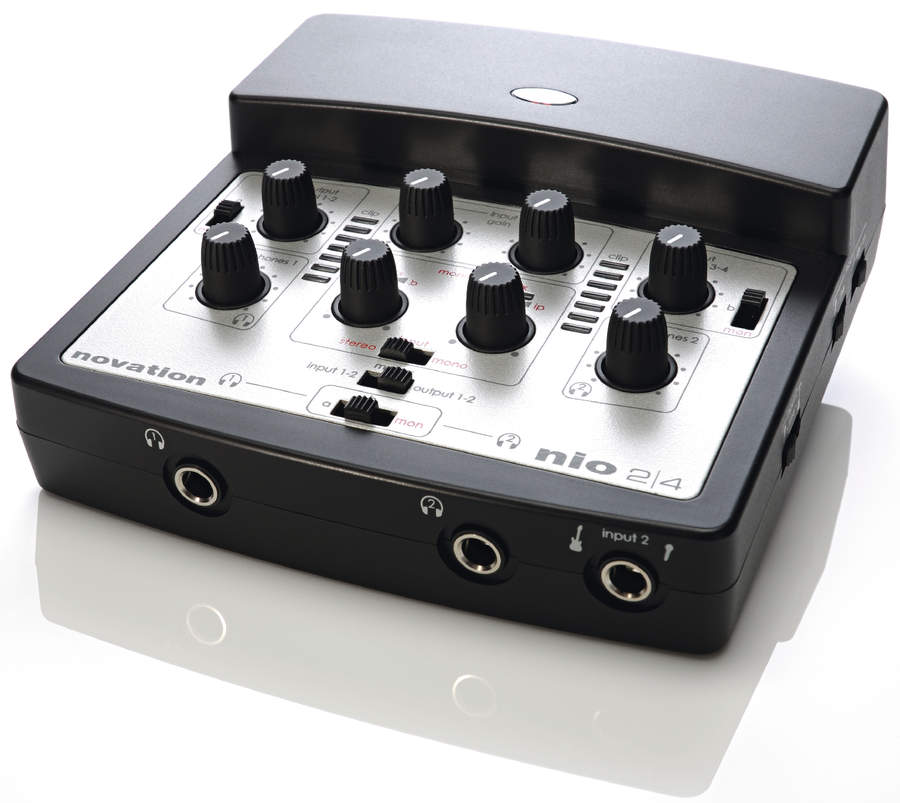MusicRadar Verdict
nio 2|4 is great value, with the exclusive effects and Direct FX technology helping to make it more than just another USB interface
Pros
- +
Well-featured for the price. Two headphone sockets. Good effects processors. Tiny latency with Direct FX. Phono outs will be great for DJs.
Cons
- -
Lots of switches can be confusing. Effects need nio hardware attached.
MusicRadar's got your back




Surely all you can expect an audio interface costing around £150 to provide is two ins, two outs, a headphone socket and precious little else. Never one to follow convention though, Novation has come up with the nio 2|4, a unit aimed at the 'do it all' producer who needs flexibility from their interface. Could this device raise the standards in terms of the features expected of an entry-level unit?
Design and features
The USB 1.1-compatible nio 2|4 is not the prettiest audio interface you'll ever come across, but we can forgive its somewhat brick-like appearance since it feels like it could survive regular outings to live venues.
The idea behind the nio 2|4 is to provide a complete package for anyone who sings, plays an instrument and/or DJs. As a result, there is - initially, at least - a baffling array of switches and dials to deal with. Input-wise, the nio can record two signals simultaneously. For one channel, you have the choice of plugging into an XLR mic input (with switchable 48V phantom power) or a line-level RCA/phono socket. The other channel can be switched between a 1/4¨ jack with line-level/guitar options and, again, an RCA/phono line-in. There are a pair of LED meters that can track either the input or output signal levels, and MIDI I/O ports too.
The outputs are where things get both interesting and complicated. There are four RCA/phono outputs: physical outputs 1/2 can convey either stereo signal A (nio outputs 1/2 from your DAW) or the monitor mix, while physical outs 3/4 can be set to yield signal A, signal B (software outs 3/4, or the FX Rack output, if you're using it) or the monitor mix. Both pairs of outs have their own volume knob.
The Monitor section has a dial to blend between software outs A and B as well as a knob to set the balance between that mix and the hardware inputs, which constitutes the final monitor mix that you hear.
Amazingly, Novation still found space for two headphone sockets. They receive the same signal, which can come from software outs A or B, or the monitor mix. Each headphone out has its own level knob, too.
This might sound like a lot to take in, but it starts to make sense when you get hands-on with the nio 2|4. For instance, you could have separate signals from your DAW and a CD player routed to the outputs and fed to a PA, while monitoring your own separate mix of the two sources.
Rack effects
Novation has teamed up with some quality developers to deliver the set of 20 'rack' units included with the nio 2|4, which, when run in standalone mode, make use of Novation's Direct FX technology.
Italian DSP wizards Overloud serve up perhaps the most exciting selection: five amp models, emulating the Vox AC30, Fender Twin, Marshall JCM900, Mesa/Boogie Dual Rectifier and Fender Bassman amps. Additionally, there are four distortion pedals, modelled on the classic Tube Screamer, Boss DS-1, Fuzz Face and Big Muff designs - we particularly enjoyed the fat and juicy tones of the latter. These guitar processors cover pretty much all tonal bases and rock as hard as you could wish for.
Focusrite (Novation's parent company) is also on hand to serve up a compressor, EQ, reverb and gate, all of which sound excellent. The EQ is a delight, and the reverb produces some great ambiences without being too system-intensive. There are five effects taken from Novation's own Supernova II synth as well: Filter (including envelope follower and LFO), Delay, Chorus, Phaser and Tremolo. Again, they sound mighty fine. Finally, there are a couple of the nio's 'own brand' processors: the Hot Tuna tuner, and Smart Hum Killer.
The effects are accessible via a rack-style GUI reminiscent of software like Guitar Rig 3 and ReValver Mk II. You simply drag the effects up and down to change their order, and you can save any preferred setups as presets (probably a good idea, since the supplied ones are pretty awful). You can select which input to patch through the rack too, so, for example, you can have an effected guitar, but a clean vocal.
The effects are available in VST/AU format as well, which is a relief. The nio FX Rack appears in your DAW as a single plug-in, allowing you to populate the rack with its processors. One drawback, however, is that you need the nio 2|4 hardware connected to use it, so an upgrade of your audio interface would mean losing this impressive set of DAW-friendly effects. Also, there's currently no support for external control of the rack via MIDI, which would be useful for, say, turning a distortion unit on and off with a MIDI foot pedal. However, Novation say that this, along with Automap support, are on the way very soon.
Audio - example song
The demo above was created entirely using the nio's VST FX Rack, with no other plug-ins used whatsoever (except for Cubase's VST Dynamics, used on the master output to stop the peaks clipping).
Latency?
Computer musicians have always had to accept some latency (the time between a note being played and the note sounding) when performing. Guitarists often make use of so-called 'direct' monitoring to eliminate delay while recording, but this means they have to perform without the signal processing they want applied to their sound. As CPU speeds increase, this is becoming less of a concern, but Novation believes it has taken a further step towards alleviating the problem with its Direct FX technology.
Novation has built 'kernel-level' effects into the 2|4's drivers, meaning that when you apply the standalone nio FX Rack to your incoming signals, the effects are still powered by your computer's CPU but don't pass through software such as your DAW, being handled instead by the drivers and routed straight back to the output, thus drastically reducing latency. In fact, Novation claims that, when using Direct FX, its latency figures beat all other audio interfaces on the market - a bold assertion.
In testing, the nio's response was so immediate that it was almost distracting at first, as we've evidently become accustomed to expecting a slight delay. Being able to monitor your audio signals with the effects applied and with almost no latency is very useful indeed, and this also facilitates nio 2|4's use as a live effects processor for guitarists, singers and other musicians.
Conclusion
If all you're looking for is a bundle of plug-in effects, then you might be better off seeking out a software package. On the other hand, if you compare the nio 2|4 to a reasonably priced hardware multi-effects unit, the £165 asking price seems a total steal. Thanks to the low, low latency of Direct FX, you can use it as you would such a piece of 'real' gear, which is great for live work.
Finally, if you don't own an audio interface and are new to the world of computer recording/DJing, or you're looking for a budget unit that allows you to use tasty guitar sounds with almost zero latency, you'd struggle to find better value for money.
MusicRadar is the number one website for music-makers of all kinds, be they guitarists, drummers, keyboard players, DJs or producers...
- GEAR: We help musicians find the best gear with top-ranking gear round-ups and high-quality, authoritative reviews by a wide team of highly experienced experts.
- TIPS: We also provide tuition, from bite-sized tips to advanced work-outs and guidance from recognised musicians and stars.
- STARS: We talk to musicians and stars about their creative processes, and the nuts and bolts of their gear and technique. We give fans an insight into the craft of music-making that no other music website can.

“Almost a lifetime ago, a few Burnage lads got together and created something special. Something that time can’t out date”: Original Oasis drummer Tony McCarroll pens a wistful message out to his old bandmates

“A high-quality solution for capturing your drums”: Sennheiser MD 421 Kompakt review

“I need to build a sound of my own that has the power that I want”: Floating Points hates festival sound systems so much that he’s invented his own









